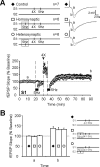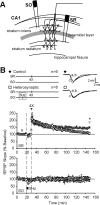Homosynaptic and heterosynaptic inhibition of synaptic tagging and capture of long-term potentiation by previous synaptic activity
- PMID: 16079404
- PMCID: PMC6725232
- DOI: 10.1523/JNEUROSCI.0909-05.2005
Homosynaptic and heterosynaptic inhibition of synaptic tagging and capture of long-term potentiation by previous synaptic activity
Abstract
Long-term potentiation (LTP) is an enhancement of synaptic strength that may contribute to information storage in the mammalian brain. LTP expression can be regulated by previous synaptic activity, a process known as "metaplasticity." Cell-wide occurrence of metaplasticity may regulate synaptic strength. However, few reports have demonstrated metaplasticity at synapses that are silent during activity at converging synaptic inputs. We describe a novel form of cell-wide metaplasticity in hippocampal area CA1. Low-frequency stimulation (LFS) decreased the stability of long-lasting LTP ["late" LTP (L-LTP)] induced later at the same inputs (homosynaptic inhibition) and at other inputs converging on the same postsynaptic cells (heterosynaptic inhibition). Significantly, heterosynaptic inhibition of L-LTP also occurred across basal and apical dendrites ("heterodendritic" inhibition). Because transient early LTP (E-LTP) was not affected by previous LFS, we examined the effects of LFS on the consolidation of E-LTP to L-LTP. The duration of E-LTP induced at one set of inputs can be extended by capturing L-LTP-associated gene products generated by previous activity at other inputs to the same postsynaptic neurons. LFS applied homosynaptically or heterosynaptically before L-LTP induction did not impair synaptic capture by subsequent E-LTP stimulation, suggesting that LFS does not impair L-LTP-associated transcription. In contrast, LFS applied just before E-LTP (homosynaptically or heterosynaptically) prevented synaptic tagging, and capture of L-LTP expression. Thus, LFS inhibits synaptic tagging to impair expression of subsequent L-LTP. Such anterograde inhibition represents a novel way in which synaptic activity can regulate the expression of future long-lasting synaptic plasticity in a cell-wide manner.
Figures







Similar articles
-
Metaplasticity of the late-phase of long-term potentiation: a critical role for protein kinase A in synaptic tagging.Eur J Neurosci. 2006 Apr;23(7):1784-94. doi: 10.1111/j.1460-9568.2006.04707.x. Eur J Neurosci. 2006. PMID: 16623835 Free PMC article.
-
A form of long-lasting, learning-related synaptic plasticity in the hippocampus induced by heterosynaptic low-frequency pairing.Proc Natl Acad Sci U S A. 2004 Jan 20;101(3):859-64. doi: 10.1073/pnas.2237201100. Epub 2004 Jan 7. Proc Natl Acad Sci U S A. 2004. PMID: 14711997 Free PMC article.
-
"Silent" metaplasticity of the late phase of long-term potentiation requires protein phosphatases.Learn Mem. 2002 Jul-Aug;9(4):202-13. doi: 10.1101/lm.498402. Learn Mem. 2002. PMID: 12177233 Free PMC article.
-
LTD, LTP, and the sliding threshold for long-term synaptic plasticity.Hippocampus. 1996;6(1):35-42. doi: 10.1002/(SICI)1098-1063(1996)6:1<35::AID-HIPO7>3.0.CO;2-6. Hippocampus. 1996. PMID: 8878740 Review.
-
Inverse synaptic tagging: An inactive synapse-specific mechanism to capture activity-induced Arc/arg3.1 and to locally regulate spatial distribution of synaptic weights.Semin Cell Dev Biol. 2018 May;77:43-50. doi: 10.1016/j.semcdb.2017.09.025. Epub 2017 Sep 23. Semin Cell Dev Biol. 2018. PMID: 28939038 Review.
Cited by
-
Sleep deprivation impairs synaptic tagging in mouse hippocampal slices.Neurobiol Learn Mem. 2018 Oct;154:136-140. doi: 10.1016/j.nlm.2018.03.016. Epub 2018 Mar 15. Neurobiol Learn Mem. 2018. PMID: 29551603 Free PMC article.
-
Brain is modulated by neuronal plasticity during postnatal development.J Physiol Sci. 2021 Nov 17;71(1):34. doi: 10.1186/s12576-021-00819-9. J Physiol Sci. 2021. PMID: 34789147 Free PMC article. Review.
-
Metaplasticity of the late-phase of long-term potentiation: a critical role for protein kinase A in synaptic tagging.Eur J Neurosci. 2006 Apr;23(7):1784-94. doi: 10.1111/j.1460-9568.2006.04707.x. Eur J Neurosci. 2006. PMID: 16623835 Free PMC article.
-
Synaptic tagging and capture in the living rat.Nat Commun. 2012;3:1246. doi: 10.1038/ncomms2250. Nat Commun. 2012. PMID: 23212375 Free PMC article.
-
Climbing fiber-evoked Purkinje cell discharge reduces expression of GABA(A) receptor-associated protein and decreases its interaction with GABA(A) receptors.J Neurochem. 2011 Apr;117(2):197-208. doi: 10.1111/j.1471-4159.2010.07119.x. Epub 2011 Mar 8. J Neurochem. 2011. PMID: 21105873 Free PMC article.
References
-
- Abraham WC, Bear MF (1996) Metaplasticity: the plasticity of synaptic plasticity. Trends Neurosci 19: 126-130. - PubMed
-
- Abraham WC, Robins A (2005) Memory retention—the synaptic stability versus plasticity dilemma. Trends Neurosci 28: 73-78. - PubMed
-
- Alger BE, Megela AL, Teyler TJ (1978) Transient heterosynaptic depression in the hippocampal slice. Brain Res Bull 3: 181-184. - PubMed
-
- Artola A, Singer W (1993) Long-term depression of excitatory synaptic transmission and its relationship to long-term potentiation. Trends Neurosci 16: 480-487. - PubMed
Publication types
MeSH terms
Substances
LinkOut - more resources
Full Text Sources
Miscellaneous
